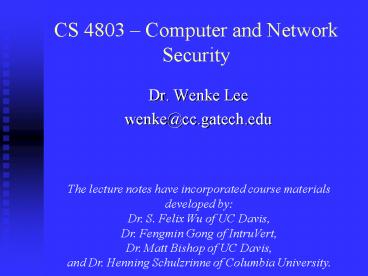CS 4803 Computer and Network Security - PowerPoint PPT Presentation
1 / 22
Title:
CS 4803 Computer and Network Security
Description:
Dr. Matt Bishop of UC Davis, and Dr. Henning Schulzrinne of Columbia University. ... Computer Security: Art and Science by Matt Bishop ... – PowerPoint PPT presentation
Number of Views:265
Avg rating:3.0/5.0
Title: CS 4803 Computer and Network Security
1
CS 4803 Computer and Network Security
- Dr. Wenke Lee
- wenke_at_cc.gatech.edu
The lecture notes have incorporated course
materials developed by Dr. S. Felix Wu of UC
Davis, Dr. Fengmin Gong of IntruVert, Dr. Matt
Bishop of UC Davis, and Dr. Henning Schulzrinne
of Columbia University.
2
Course Objectives
- Understanding of basic issues, concepts,
principles, and mechanisms in information
security. - Security goals and threats to computer and
networking infrastructure and applications. - Introduction to cryptography.
- System security applications.
- Network security applications.
- Exposure to commercial as well as research
security technologies.
3
Course Styles
- Descriptive what is out there.
- Critical what is wrong with ...
- Skill oriented homework with programming and lab
projects. - Explore!
- Interactive discussion and questions encouraged
and considered in grade - Students are encouraged to present their findings
- Information sharing home page and message
board/email list.
4
Course Outline
- Fundamentals
- Overview of computer security
- Fundamental results
- Security policy and models
- Design principles and implementation issues
- Vulnerability analysis and auditing
- Program security, operating system security, and
database security - Cryptography
- Secret key cryptography
- Hashes and message digests
- Public key cryptography
- Information hiding
5
Course Outline - Contd
- Network and system security applications
- Authentication and security handshakes pitfalls
- IP security
- Web and E-commerce
- Virus/worm detection, firewalls, intrusion
detection. - Hacking and forensics
- Writing secure code
6
Prerequisites
- Operating systems, networking, discrete
mathematics, and programming (C or C, Java).
7
Textbooks and References
- Required textbooks
- Computer Security Art and Science by Matt Bishop
- Network security PRIVATE communication in a
PUBLIC world by Kaufman, Perlman, and Speciner. - Reference text(s) and papers
- Security in Computing by Charles Pfleeger and
Shari Pfleeger. - Additional materials see course Web page.
8
Course Mechanics
- WWW page
- For course materials, e.g., lecture slides,
homework files, papers, tools, etc. - Grading 60 homework, 15 midterm, and 25 final
(or course project) - Course participation 5 extra credits.
9
Motivations
10
Why Is Security Important
- Computers and networks are the nerves of the
basic services and critical infrastructures in
our society - Financial services and commerce
- Transportation
- Power grids
- Etc.
- Computers and networks are targets of attacks by
our adversaries
11
A Motivating Example
- Requirements of an e-Commerce site
- Performance
- of current transactions
- Usability
- Easy to follow GUIs, convenience (cookies?)
- Security
- Secure transmission and storage of costumer
financial/personal data - Protect the Web servers and the enterprise
network from illegitimate access - Provide continuous/uninterrupted services
12
Why Is Security Hard (and Harder)
- The complexity of computers and networks
- User expectation
- User ignorance
- Social engineering
- Defense is inherently more expensive
- Offense only needs the weakest link
13
Trends by Application Demands
- Hunger for bandwidth
- Hardware (Physics) breakthroughs seem to come
easier than software - Wider spectrum of application sophistication
- Best-effort to guaranteed
- Built-in security?
- Drive for ubiquitous access
- Economics/profitability
14
Quest for Better Services
- Real-time audio/video requires guaranteed
end-to-end delay and jitter bounds. - Adaptive multimedia application requires minimum
bandwidth and loss assurance. - Intelligent application demands reliable feedback
from the network. - Security.
15
Quest for Ubiquitous Access ...
- Information age is a reality.
- Everything depends on reliable and efficient
information processing. - Quality of our everyday life.
- Development of national/world economy.
- Security of national defense/world peace.
- Networking is one critical part of this
underlying information infrastructure!
16
Economic Pressure
- Service providers want the most bang on their
buck - the most profitable technology? - Cautious adoption of new technologies
- Even for security
- Emphasis on leveraging deployed technologies
- Increased utilization of existing facilities
17
Networking Technologies
- Switching modes.
- Circuit switching.
- Packet switching - Ethernet, HIPPI, fiber
channel, IP routing, frame relay, ATM, IP
switching/tag switching. - High-speed transmission media.
- SONET/SDH, WDM.
- Ubiquitous access media.
- xDSL/cable modem, IEEE802.11, LEOSs.
- We will study the common security issues.
18
The Internet
19
Layered Store-and-forward
User A
User B
Application
Transport
Network
Link
20
Security Implications
- Vulnerabilities - from weak design, to
feature-rich implementation, to compromised
entity - Heterogeneous networking technologies adds to
security complexity - But improves survivability
- Higher-speed communication puts more information
at risk in given time period - Easier to attack than to defend
- Ubiquitous access increases exposure to risks
21
The Good News ...
- Plenty of basic means for end-user protection -
authentication, access control, integrity
checking - Intensive RD effort on security solutions
(government sponsored research private industry
development) - Increasing public awareness of security issues
- New crops of security(-aware) researchers and
engineers - YOU!
22
The Bad News ...
- (Existing) information infrastructure as a whole
is very vulnerable, which makes all critical
national infrastructure vulnerable - e.g., Denial-of-service attacks are particularly
dangerous to the Internet infrastructure - Do we continue to band-aid or re-design?
- Serious lack of effective technologies, policies,
and management framework































